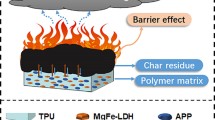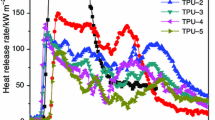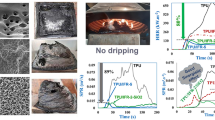Abstract
Flame retardant thermoplastic polyurethane (TPU) composites with low smoke release have been prepared by melt-blending TPU with commercially available carbon black (CB) and ammonium polyphosphate (APP). The experimental data from SDT indicated that an appropriate amount of CB and APP can decrease the amount of smoke production in the test with or without flame. The CCT results showed that CB and APP greatly decrease smoke production rate, total smoke release, and smoke factor of flame retardant TPU composites compared with that of pure TPU. Indeed, CB is considered as an effective smoke suppression agent and a good synergism with APP in flame retardant TPU composites, which can greatly improve the structure of char residue realized by TG and SEM results. The TG and DTG results showed that CB can decrease the initial decomposition temperature and improve the thermal stability at high temperature for flame retardant TPU composites. More interest, the TG-IR study indicates that the volatilized products are CO2, ammonia compound, acid anhydride, water, alkane compounds, and aromatic compounds according to the temperature of onset formation. This is a very meaningful result in fire safety materials fields.










Similar content being viewed by others
References
Carty P, Creighton JR, White S. TG and flammability studies on polymer blends containing acrylonitrile-butadiene-styrene and chlorinated poly(vinyl Chloride). J Therm Anal Calorim. 2001;63(3):679–87.
Chen XL, Jiang YF, Jiao CM. Smoke suppression properties of ferrite yellow on flame retardant thermoplastic polyurethane based on ammonium polyphosphate. J Hazard Mater. 2014;66:114–21.
Chen MJ, Chen CR, Tan Y, Huang JQ, Wang XL, Chen L, Wang YZ. Inherently flame-retardant flexible polyurethane foam with low content of phosphorus-containing cross-linking agent. Ind Eng Chem Res. 2014;53(3):1160–71.
Formicola C, Fenzo AD, Zarrelli M, Giordano M, Antonucci V. Zinc-based compounds as smoke suppressant agents for an aerospace epoxy matrix. Polym Int. 2011;60(2):304–11.
Liu Y, Liu MF, Xie DY, Wang Q. Thermoplastic polyurethane-encapsulated melamine phosphate flame retardant polyoxymethylene. Polym-Plast Technol. 2008;47(3):330–4.
Harashina H, Tajima Y, Itoh T. Synergistic effect of red phosphorus, novolac and melamine ternary combination on flame retardancy of poly (oxymethylene). Polym Degrad Stabil. 2006;91(9):1996–2002.
Allcorn EK, Natali M, Koo JH. Ablation performance and characterization of thermoplastic polyurethane elastomer nanocomposites. Compos Part A Appl Sci Manuf. 2013;45:109–18.
Xu Y, Chen M, Ning X, Chen XL, Sun ZD, Ma YH, Yu J, Zhang ZB, Bo XJ. Influences of coupling agent on thermal properties, flammability and mechanical properties of polypropylene/thermoplastic polyurethanes composites filled with expanded graphite. J Therm Anal Calorim. 2014;15(1):689–95.
Jiang SH, Shi YQ, Qian XD, Zhou KQ, Xu HY, Lo SM, Gui Z, Hu Y. Synthesis of a novel phosphorus- and nitrogen-containing acrylate and its performance as an intumescent flame retardant for epoxy acrylate. Ind Eng Chem Res. 2013;52(49):17442–50.
Bourbigot S, Samyn F, Turf T, Duquesne S. Nanomorphology and reaction to fire of polyurethane and polyamide nanocomposites containing flame retardants. Polym Degrad Stabil. 2010;95(3):320–6.
Jiao CM, Zhao XL, Song WK, Chen XL. Synergistic flame retardant and smoke suppression effects of ferrous powder with ammonium polyphosphate in thermoplastic polyurethane composites. J Therm Anal Calorim. 2015;120(2):1173–81.
Laoutid F, Bonnaud L, Alxandre M, Lopez-Cuesta JM, Dubois P. New prospects in flame retardant polymer materials: from fundamentals to nanocomposites. Mater Sci Eng, R. 2009;63(3):100–5.
Wu JP, Zhang Y, Luo XJ, She YZ, Yu LH, Chen SJ, Mai BX. A review of polybrominated diphenyl ethers and alternative brominated flame retardants in wildlife from China: levels, trends, and bioaccumulation characteristics. J Environ Sci China. 2012;24(2):183–94.
Velencoso MM, Ramos MJ, Klein R, Lucas AD, Rodriguez JF. Thermal degradation and fire behaviour of novel polyurethanes based on phosphate polyols. Polym Degrad Stabil. 2014;101:40–51.
Subasinghe A, Bhattacharyya D. Performance of different intumescent ammonium polyphosphate flame retardants in PP/kenaf fibre composites. Compos Part A Appl Sci Manuf. 2014;65:91–9.
Janowska G, Rybiński P. Influence of carbon black on thermal properties and flammability of cross-linked elastomers. J Therm Anal Calorim. 2008;91(3):697–701.
Zhang QJ, Zhan J, Zhou KQ, Lu HD, Zeng WR, Stec AA. The influence of carbon nanotubes on the combustion toxicity of PP/intumescent flame retardant composites. Polym Degrad Stabil. 2015;115:38–44.
Omnès B, Thuillier S, Pilvin P, Grohens Y, Gillet S. Effective properties of carbon black filled natural rubber: experiments and modeling. Compos Part A Appl Sci Manuf. 2008;39(7):1141–9.
Wen X, Tian NN, Gong J, Chen Q, Qi YL, Liu Z, Liu J, Jiang ZW, Chen XC, Tang T. Effect of nanosized carbon black on thermal stability and flame retardancy of polypropylene/carbon nanotubes nanocomposites. Polym Adv Technol. 2013;24(11):971–7.
Chen XL, Jiao CM. Thermal degradation characteristics of a novel flame retardant coating using TG-IR technique. Polym Degrad Stabil. 2008;93(12):2222–5.
Dong YY, Gui Z, Hu Y, Wu Y, Jiang SY. The influence of titanate nanotube on the improved thermal properties and the smoke suppression in poly(methyl methacrylate). J Hazard Mater. 2012;209:34–9.
Ricciardi MR, Antonucci V, Zarrelli M, Giordano M. Fire behavior and smoke emission of phosphate-based inorganic fire-retarded polyester resin. Fire Mater. 2012;36(3):203–15.
Tsai KC. Orientation effect on cone calorimeter test results to assess fire hazard of materials. J Hazard Mater. 2009;172(2):763–72.
Schartel B, Hull TR. Development of fire-retarded materials-Interpretation of cone calorimeter data. Fire Mater. 2007;31:327–54.
Zhang P, Song L, Lu HD, Hu Y, Xing WY, Ni JX, Wang J. Synergistic effect of nanoflaky manganese phosphate on thermal degradation and flame retardant properties of intumescent flame retardant polypropylene system. Polym Degrad Stabil. 2009;94(2):201–7.
Hu WZ, Zhan J, Wang X, Hong NN, Wang BB, Song L, Stec AA, Hull TR, Wang J, Hu Y. Effect of functionalized graphene oxide with hyper-branched flame retardant on flammability and thermal stability of cross-linked polyethylene. Ind Eng Chem Res. 2014;53(8):3073–83.
Paliesková J, Pajtášová M, Feriancová A, Ondrušová D, Holcová K, Vavro J. Thermal properties of fillers based on organoclays in the polymeric materials. J Therm Anal Calorim. 2015;119(2):939–43.
Li LL, Wang G, Wang SY, Qin S. Thermogravimetric and kinetic analysis of energy crop Jerusalem artichoke using the distributed activation energy model. J Therm Anal Calorim. 2013;114(3):1183–9.
Chen XL, Zhuo JL, Jiao CM. Thermal degradation characteristics of flame retardant polylactide using TG-IR. Polym Degrad Stabil. 2012;97(11):2143–7.
Chen XL, Jiao CM, Zhang J. Microencapsulation of ammonium polyphosphate with hydroxyl silicone oil and its flame retardance in thermoplastic polyurethane. J Therm Anal Calorim. 2011;104(3):1037–43.
Simkovic I. TG/DTG/DTA evaluation of flame retarded cotton fabrics and comparison to cone calorimeter data. Carbohyd Polym. 2012;90(2):976–81.
Jiao CM, Dong J, Chen XL, Li SX. Influence of T31 content on combustion and thermal degradation behaviors on flame-retardant epoxy composites. J Therm Anal Calorim. 2013;114(3):1201–6.
Kunze R, Schartel B, Bartholmai M, Neubert D, Schriever R. TG-MS and TG-FTIR applied for an unambiguous thermal analysis of intumescent coatings. J Therm Anal Calorim. 2002;70(3):897–909.
Li YT, Li B, Dai JF, Jia H, Gao SL. Synergistic effects of lanthanum oxide on a novel intumescent flame retardant polypropylene system. Polym Degrad Stabil. 2008;93(1):9–16.
Pan MZ, Mei CT, Du J, Li GC. Synergistic effect of nano silicon dioxide and ammonium polyphosphate on flame retardancy of wood fiber–polyethylene composites. Compos Part A Appl Sci Manuf. 2014;66:128–34.
Giron D. Applications of thermal analysis and coupled techniques in pharmaceutical industry. J Therm Anal Calorim. 2002;68(2):335–57.
Isitman NA, Kaynak C. Nanoclay and carbon nanotubes as potential synergists of an organophosphorus flame-retardant in poly(methyl methacrylate). Polym Degrad Stabil. 2010;95(9):1523–32.
Acknowledgements
The authors gratefully acknowledge the National Natural Science Foundation of China (Nos. 51106078, 51206084), the University Research and Development Projects from Shandong Province (J14LA13), and the Major Special Projects of Science and Technology from Shandong Province (2015ZDZX11011).
Author information
Authors and Affiliations
Corresponding author
Rights and permissions
About this article
Cite this article
Liu, L., Zhao, X., Ma, C. et al. Smoke suppression properties of carbon black on flame retardant thermoplastic polyurethane based on ammonium polyphosphate. J Therm Anal Calorim 126, 1821–1830 (2016). https://doi.org/10.1007/s10973-016-5815-x
Received:
Accepted:
Published:
Issue Date:
DOI: https://doi.org/10.1007/s10973-016-5815-x




